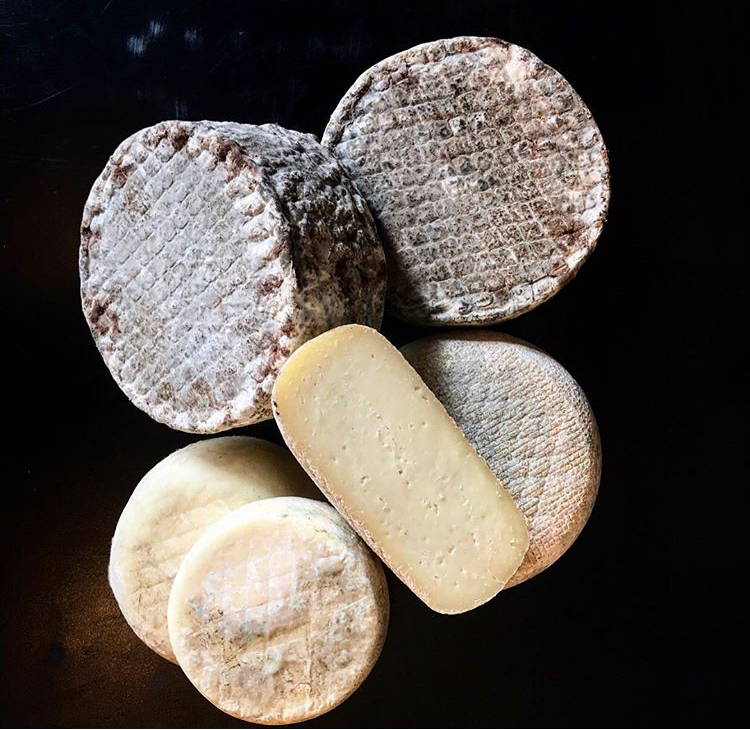PRESERVATION can mean many things, and may take multiple forms. But perhaps one of its most curious instances is found in the 11th century convent which houses the relics of Saint Valentine, in the medieval village of Sassocorvaro.

Pecorino From The Pit
Pecorino Di Fossa: 'Pecorino From The Pit'
Here, every August, young shepherd and cheesemaker Emilio Spada brings his spring and summer raw milk pecorino. He is bringing them for burial in an ancient pit which extends some 3.5 meters deep into the local tuffa stone, beneath the reliquary chapel. This pit, like others in the Marche region, is part of the local architectural, and cultural fabric: these structures date back at least to the 15th century, when they were first documented. They served originally as food stores, preserving food (largely grain) for winter and protecting it from marauders, but with time, the marked organoleptic qualities of the cheese stored in these pits gave rise to a tradition of maturation - and to a style of cheese known as formaggio di fossa: cheese from the pit. The secret was the terroir: in the indigenous yellow tuffa, a highly breathable stone, and the presence of subterranean water repositories, which provided optimal humidity and fed the soil with the minerals which give the particular mineral, vegetal flavour to this cheese.
By the time he buries his cheeses in August, Emilio will have matured his pecorino for several months, an essential period in which the rinds and molds become established, and live cultures in the cheese are prepared for ‘activation’ within the environment of the pit. The oldest cheeses are lowered in first, in cloth sacks, working up in layers with the youngest on top. The environment of his fossa is Emilio’s alone, and it is a pure experimental space, where he is able to manipulate elements such as the wild herbs that are interleaved with the layers of cheeses in the pit and which, along with threshing straw, impart vegetal and spicy aroma to the cheese. The pecorino are then left there in the dark for 100 days, to ferment anaerobically in temperatures of 48/50c before they will be ceremonially unearthed in November for the Rite della Sfossata. This ritual (which typically takes place on St. Catherine’s Day) coincides with the end of harvest and the start of winter, and the transition from fresh foods to stored foods, situating the cheese firmly within seasonal cycles.
The unearthing celebrates, as much as the cheese, the powerful aroma of Emilio’s mountain, its grasses, wildflowers and soil - released in a rush into the room before the cheeses are even revealed to sight. Ripened, they have lost 15% of their original mass and become curiously misshapen, impacted by the pressure of the earth.
Four months on, and we’re meeting this Pecorino di Fossa in Bermondsey for the first time, to mark the second of our arch dinners with Guiseppe Cimmino and Peppeckish. The cheeses will have ripened further since their unearthing and their pungent, unmistakable aroma will be at its most powerful.
Cau E Spada: Emilio, The New Generation
Cau e Spada's Razza Sarda sheep graze organic pastures most of the year, and feed on hay from these same fields over the winter.
PECORINO di fossa is just one of Emilio’s pecorinos; but a true index of a signature style which combines ancient and modern. His dairy may be remote, and in many ways sealed into a past order and way of life, but his cheesemaking is not nostalgic or even purely traditional. At Cau e Spada, the family farm named for his parents, cheesemaking does not sit still - it has always been pioneering and, with Emilio now at the helm, the cheese are more than ever in experimental flux.
Emilio’s family have made pecorino since they first owned a sheep, back before they owned land in Sardinia. But when they brought that tradition to le marche, they also integrated sardinian tradition with a new terroir, and a new human temperament. Le Marche might look traditional, but it is also a curious outpost of revolutionary spirit, settled in the 1970s by a wave of left wing intellectualism which brought progressive agricultural theory to this part of the world. Everything here, wherever you look, is minimal intervention - the landscape cast as the solution to the metropolis and its integrity protected and strengthened by the people who live here. The Cau e Spada farm has grown in that spirit.
Today, their 1,700 strong flock of Razza Sarda sheep graze organic pastures that encompass two different terroirs: the more austere hills towards the Apennines and the sweeter pastures that slope towards the sea. In the winter, the sheep feed on the farm’s own hay. Emilio conducts the passage of the sheep so as to harness the different floras, and so fine tune the flavours he looks for in the milk. He does the same in his maturation rooms, playing his two available winds - the fierce, drying Tramontana, and the damp Garbino - off against each other to provide the ideal conditions for ripening. The cheeses sit on fir and ripe cherry boards, in some instances on walnut leaves: every detail looks towards expressing the complex, layered flavour of his flock’s milk.
Emilio sends us four pecorino, from Spring through to late Autumn: a 3 week pecorino fresco, a 2 month semi-stagionata, a 6 month stagionata and - most unusually - a cheese which he calls San Giorgio. An old recipe from his father, it is named for the patron saint of the family’s Sardinian birthplace, the town of Sini. But a very unprecedented cheese has been built on those old foundations. San Giorgio is inspired by what Emilio calls the ‘English School’: it’s a cheese of unusually high acidity, an acidity that we’d associate with a cheshire, rather than a pecorino, and in Italy would be equalled only in a fresh robiola. Mould-ripened, with a chalky, friable core and mushroomy breakdown under a rind of leaf litter and hummus, San Giorgio looks nothing like a traditional pecorino. But it looks, and tastes, very reminiscent of caerphilly. Emilio would say that the best way to preserve tradition is to take it somewhere new, keep it alive and vital. Cheeses like the San Giorgio, and the Pecorino di fossa are just that.

